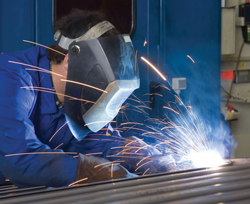Manufacturing review
 Signs of recovery are appearing as industrial output rises again.
Signs of recovery are appearing as industrial output rises again.
Northern Ireland’s manufacturing sector is bucking the UK trend with rising output recorded in 2012’s first quarter and industrial customers investing in new machinery to grow their own businesses.
As measured by the Northern Ireland Statistics and Research Agency’s Index of Production, manufacturing output rose by 0.7 per cent between Q4 2011 and Q1 2012, while overall UK output levelled out with 0 per cent change.
For the province’s factories, this represents a 1.4 per cent increase on Q1 2012 and 4.8 per cent growth over the last four quarters. Manufacturing stood at 92.1 per cent of 2008 levels.
All main industrial categories reported increases over the year:
- engineering and allied industries (+7.9 per cent);
- textiles, leather and related products (+7.9 per cent);
- basic and fabricated metal products (+5.8 per cent);
- food, beverages and tobacco (+0.5 per cent); and
- chemical and pharmaceutical products (+0.4 per cent).
However, the ‘other manufacturing’ sub-sector recorded a 5.3 per cent annual decrease and has experienced a 33 per cent drop since its peak in Q4 2007. This trend is driven by the fall in construction, which means that less cement, lime, plaster and concrete is being manufactured.
The minimal increases for food, drink, chemicals and pharmaceuticals are not necessarily bad news as their output trends have remained relatively constant over the course of the recession. The downturn in textiles started much earlier, peaking in Q1 2004 and losing 27.6 per cent of its output since then.
A 7.8 per cent annual increase in the production of investment goods (i.e. plant and machinery) is viewed as a good sign of recovery, as this indicator had fallen by 37.3 per cent between Q4 2007 and Q3 2009: the worst phase of the global recession. This co-incided with significant falls in the province’s engineering and metal product outputs: 13.9 and 27.4 per cent respectively.
Many firms were struggling to survive, and therefore cut back on capital investment, but recent increases suggest that companies are investing and seeking to grow again.
Production of consumer goods, by comparison, rose by just 0.8 per cent over the year and indeed fell by 4.8 per cent between Q4 2011 and Q1 2012. Consumer goods had performed relatively well during the recession but inflation and wage constraints in 2011 kept shoppers at home.
The figures were published on the same day as a slight rise in unemployment (0.1 per cent) and a marked fall in services activity (1.6 per cent) were announced. Enterprise Minister Arlene Foster therefore saw the improved industrial output as “particularly welcome”.
Foster stated: “We have undoubted strengths in advanced engineering and materials, agri-food, life sciences and information technology that we need to continue to market overseas.” She pointed to her visit to Kurdistan with Invest NI in July, and forthcoming missions to China, Malaysia, Germany and the United Arab Emirates; the latter two will focus on the health and life sciences sectors.
The Q1 2012 statistics were released on 18 July and data for Q2 2012 will be published on 17 October.





